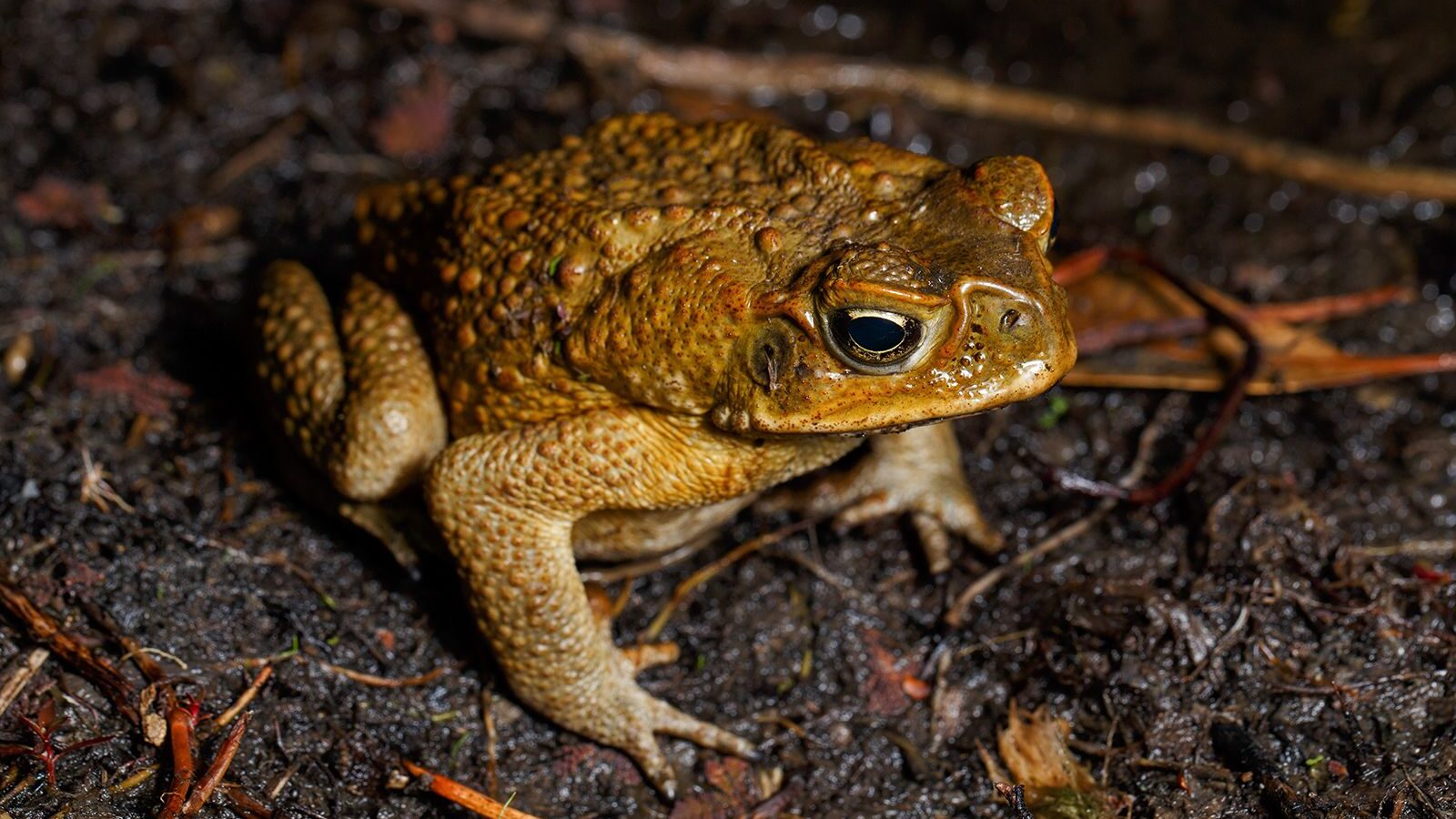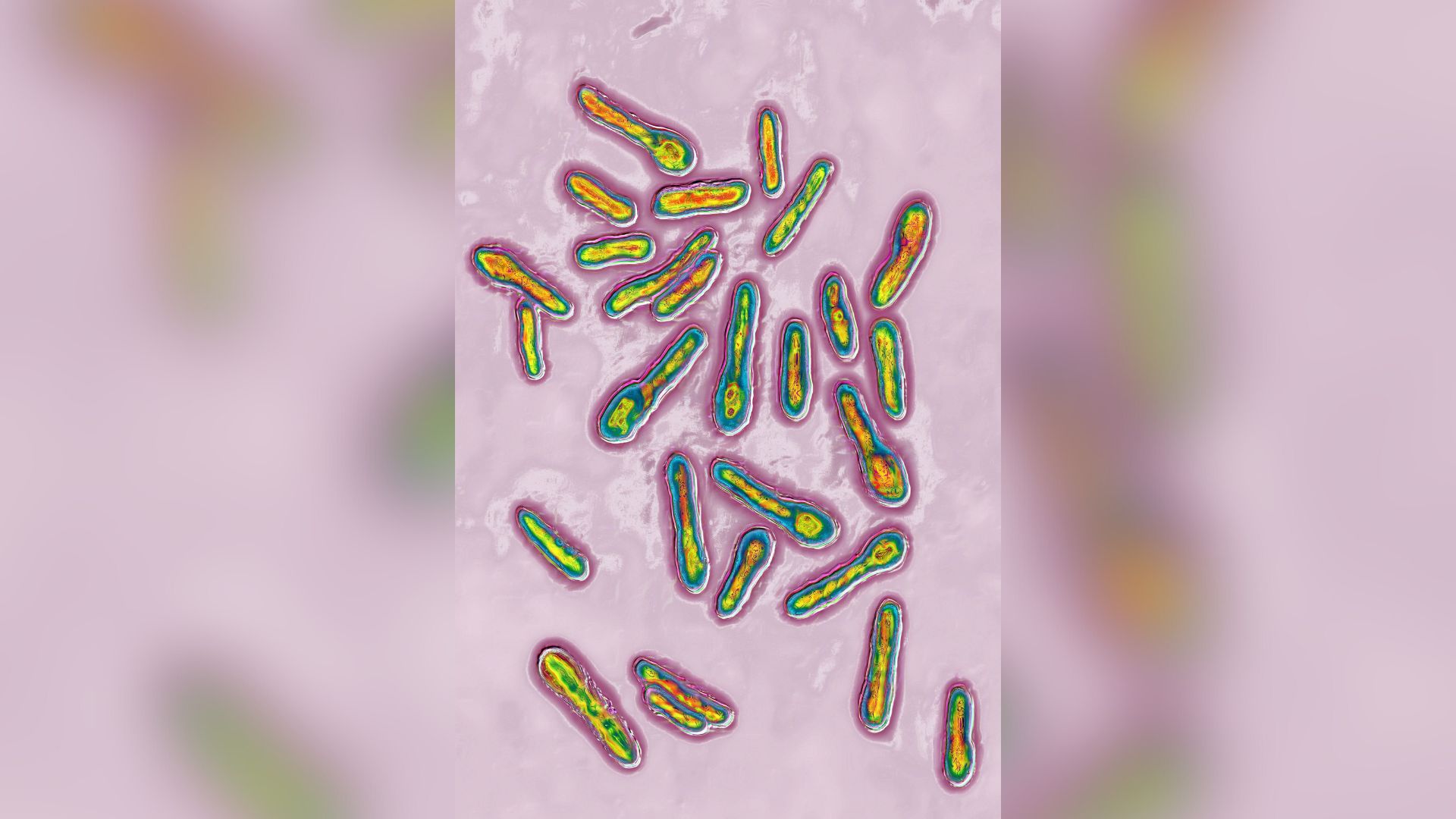This warty, toxic pest threatens entire ecosystems. These scientists have a secret weapon
Jan 20, 2024, 5:30 AM

Cane toads produce poison in large glands perched on their shoulders that's fatal for some animals. ( Joshua Prieto/SOPA Images/LightRocket/Getty Images)
( Joshua Prieto/SOPA Images/LightRocket/Getty Images)
Brisbane, Australia (CNN) — On the edge of a dark, suburban park in Brisbane, teams of volunteer toad-catchers gather around Gary King as he shoves another squirming specimen into a cooler box.
“Who’s got some more?” asks King, a local leader of this year’s Great Cane Toad Bust, a small and ultimately futile campaign to dent Australia’s massive invasive population of some 200 million cane toads.
Native to South and Central America, the brown, warty-skinned pest has been causing havoc in Australia since being released in the northern state of Queensland to eat cane beetles in 1935.
Since then, they’ve spread north, south and thousands of miles to the west, hitching rides on vehicles and developing stronger, longer legs to hop across state borders, poisoning native fauna with their toxic glands as they go.
Australia’s not the only country with a cane toad problem – the United States, Japan, the Philippines, Papua New Guinea and islands in the Pacific and Caribbean also host the species, either through accident or mislaid hopes that they would solve another pest-related problem.
Cane toads are unwelcome in Australia because the bulbous amphibian is a voracious eater that when stressed releases a toxin strong enough to kill lizards, snakes, crocodiles – almost anything that dares to attack it. In a suburban setting, that includes dogs and cats.
The toads are toxic at every stage of their life cycle and ingesting their poison – emitted from bulky glands on their shoulders – can cause rapid heartbeat, convulsions, paralysis and even death for some animals. In humans it can cause intense pain.
For the most part, the battle against cane toads has been mounted by local ecological warriors wearing rubber gloves who scan the streets for adult toads. But the Australians have a secret weapon not yet available worldwide – a lure that attracts cane toad tadpoles so thousands can be killed in one hit.
Cane toad culls
In Brisbane, King’s volunteer toad busters include father and son team Luke and Austin Rogers, who moved to Australia from the United Kingdom over a decade ago.
They don’t normally do this kind of thing; fishing is more typical of their father-son expeditions.
But as they scan the ground, wearing rubber gloves and head torches, the competitive element of toad-catching takes over, delivering the same dose of adrenaline as the first nibble on a hook.
Luke spots a particularly large specimen in a puddle, but as he bends down to grab it, it jumps away and he gives chase, triumphantly slipping it into a bucket that’s getting heavier with each catch.
Does he think he’s putting much of a dent in the population?
“I’m doing it half because I enjoy it,” he says. “There’s definitely part of me that thinks we’re not even going to scratch the surface.”
A more efficient method of eradicating toads has already been invented that targets the tadpoles that hatch from clutches of up to 30,000 eggs.
It’s the collaborative work of Professor Rob Capon, a natural products chemist from the University of Queensland and Professor Rick Shine, an evolutionary biologist and ecologist from Macquarie University.
Shine, one of Australia’s leading authorities on cane toads, had noticed that even in murky water, cane toad tadpoles were able to swim toward eggs laid by rival females, which they’d eat for nutrition and to build their stores of toxins.
In the laboratory, Capon set out to find out why.
“It turned out that they were tracking in on some sort of chemical cue that was released by the eggs,” Capon said.
To prove the theory, and try to mimic it, they’d first need a heap of dead cane toads.
Initially, their efforts to obtain corpses were somewhat frustrated by the university’s ethical obligations to ensure the animals were killed humanely for scientific study, said Capon.
A humane death was hard to guarantee in a state where toads were once hunted with hockey sticks and golf clubs in an unofficial sport.
“I grew up being told that it was fun to kill cane toads and you could do so in ways that were as painful as possible for the animal,” says Shine, who was born in Queensland.
“I guess my perspective now is, it’s not the toad’s fault. It didn’t come to Australia of its own accord,” he said.
“We want to get rid of them, but we need to do so with as much humanity as if we were trying to get rid of koalas.”
Beginnings of the challenge
To satisfy the university’s ethics committee and obtain the requisite number of dead toads, Capon and his team created the “Cane Toad Challenge.”
The program encouraged backyard hunters to find the toads and send in their catch. And it reaped enough dead toads to keep the university supplied with subjects for several years of testing.
During that time, Capon and his team identified the pheromone that attracts the tadpoles, extracted it from toads and processed it into a liquid that can be used to bait a lure.
The lure – a drenched stone – is placed inside a trap that’s submerged near tadpoles, tempting them to swim in through a hole.
The recommended method for killing tadpoles and adult cane toads in Australia is to put them in the fridge for 24 hours, then freeze them for another day or two before putting them in the trash.
For obvious reasons, killing cane toad tadpoles en masse is far more efficient than picking up fully grown adults, Capon said.
But even he admits that eliminating cane toads in Australia is an impossible task.
“Toad busting is terrific. Tadpole trapping is a really good adjunct to toad busting because if you can pick up the adults and you take out the tadpoles, you’ve got a bigger buffer for the next generation,” he said.
“But Australia is a big place. And there’s lots of places that toads are happily living where there’s nobody to do tadpole trapping or toad busting.
“So, unless you’re going to stick an army of retirees on a bus across North Queensland every week of every summer, we’re not going to get rid of the toads.”
The problem in Florida
The southwestern state of Florida in the United States has a similar warm climate to Queensland, with plenty of cane toads and not enough retirees to catch them all.
Like in Australia, cane toads were introduced in Florida in the 1930s to attack cane beetles, but the local theory suggests their numbers really took off by accident in the 1950s.
“The running narrative right now is that there were those initial attempts, none of them worked, but then somehow this giant crate full of 20 or so toads got busted open in Miami airport. And because it was warm enough down there, they became established,” said Jacob LaFond, a lab coordinator and instructor at the University of Tampa.
So far, they haven’t moved beyond the peninsula – it’s too cold up north – and it seems they prefer human habitats to Florida’s natural environment.
That means cats and dogs tend to be more vulnerable than Florida’s wildlife, which is accustomed to living alongside other types of toxic toads.
“There’s no evidence that there’s a lot of toxic poisoning of native wildlife here in Florida,” said Steve Johnson, a professor in Wildlife Ecology & Conservation at the University of Florida.
“In Florida, cane toads are mainly a socio-economic issue. If you have a dog that attacks a cane toad or eats one and dies, if you’re a dog lover, that’s a major blow to you, and then there’s the costs associated with taking a dog to the vet,” he said.
Experts say there’s no big government campaign to eradicate cane toads, because Florida has bigger issues with invasive pests.
“We have these giant Burmese pythons that are eradicating a lot of the ecosystem in South Florida. We have these iguanas that are building tunnels that are messing with our highway infrastructure. So, I certainly understand why the toads have taken a back seat,” LaFond said.
That’s not to say that no one is interested.
Nikki Tomsett, an invasive species project officer at Australian not-for-profit Watergum, which is about to begin producing Capon’s tadpole lures, says most of the emails she receives from outside Australia are from Hawaii and Florida.
The lures aren’t available for distribution outside Australia yet – the group is still working through licensing issues – but Tomsett suggests it isn’t a quick fix for the US. More rigorous testing is needed in the field to ensure native toads – including the southern toad – don’t become bycatch.
“For us, not being familiar with the southern toad and the ecology of Florida, we would need to do some more trials and a lot of research and development,” Tomsett said.
Slowing the cane toad advance
As Florida’s numbers multiplied, small businesses offering toad-busting services sprang up offering regular toad maintenance for homes.
Australia takes more of a DIY approach in the suburbs, while a much more vigorous campaign is underway by state authorities to slow their rapid march west.
The cane toad front line now sits near the town of Derby in Western Australia – and is moving toward the coast at about 50 kilometers (31 miles) a year.
That means it’s likely to hit the coastline in the next two years, and while authorities are working to slow its progress, they’re also preparing native animals for the inevitable onslaught.
As well as manual toad catching and tadpole baiting, native animals are being fed cane toad flesh laced with poison or nausea-inducing chemicals to make them sick.
The idea is that they learn not to eat cane toads before the arrival of large, toxic adult males.
“We drop those baits just before the frontline arrives, and then when the cane toads do arrive, that animal won’t go for a cane toad because it’s already tried a sausage and felt sick,” said Sara McAllister, an invasive species project officer from the Western Australia Department of Biodiversity, Conservation and Attractions.
“If we just let nature run its course and we have the large highly toxic toads coming into the environment first, then you see a lot of animals die.”
The style of bait depends on the animals being targeted; they’re chosen with guidance from local Aboriginal rangers who have intimate knowledge of the land and its inhabitants.
Northern quolls – small carnivorous marsupials – get a cane toad sausage, goannas are fed tiny live toads and freshwater crocodiles receive cane toad legs with a dose of lithium chloride.
Back in Brisbane, the clear winner of the evening’s toad hunt was 9-year-old Connor Holmes, who with his father John caught 25 toads in just over an hour.
“We have a system, don’t we? I hold the bucket. And he catches,” John said.
“Because I’m the faster one,” Connor explains.
They say they’d go cane toad catching more often, if only for one issue.
“I don’t think the wife would appreciate the buckets of toads in the freezer,” John says. “That is the problem.”
The-CNN-Wire
™ & © 2024 Cable News Network, Inc., a Warner Bros. Discovery Company. All rights reserved.













